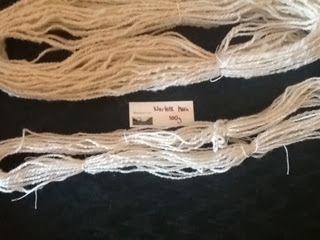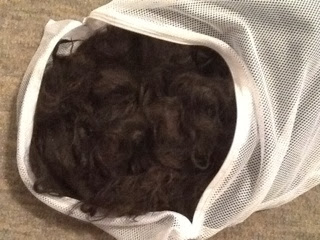The Fiber Fest in Greencastle Ind is always the second weekend of April, on Friday and Sat. Due to working every other weekend, I haven't been there for a couple of years, so I was happy that it worked out hubby and I could take a day trip and go up to it this year.
This is a nostalgic trip for us, since I use to have a booth there. Hubby is fond of the phrase, 'it's just not the same' but then what is? I personally think change is good and that includes fiber fairs. The biggest change I see now is the increased number of brick and mortar yarn stores, making the fiber festivals tour. It is still up in the air if this is bringing in more customers, but knowing how quickly some knitters become spinners, it seems a perfect choice.
I saw less raw fleece this year, but that was probably because I had my blinders on. I told hubby when we arrived this would be the first year I would not buy raw fleece. And I didn't. I almost caved when he pointed out a booth full of lovely fleeces. Who knew the smell of lanolin was so addicting.
I am trying to focus on buying processed roving, and the one purchase I did make was from Sheep Street. They raise Shetlands, and had some processed which Nancy then dyed. I bought a nice 8 oz bump, and love the fall color of it.
I bought a Tshirt too, with a spinning wheel on it and the words 'I have a PHD in spinning'. In tiny letters by the PHD it says 'projects half done'. Oh my how true!
The second festival I got to attend this spring was the Ky Sheep and Wool Festival. This time I left hubby at home and went with a group of spinner friends, including my daughter and grandson. At 2 years old, grandson is still is a restrained onlooker, who's big moment was petting a sheep. His involvement in shopping was the huggable ness of the fiber or yarn. His 'ahhh' while doing so melts your heart.
I did much more shopping this trip. First I found 4 oz of this lovely Jacob roving, from a heritage family farm in Pa called Ross Family Farms.
Then I found Dyed in the Wool's booth. They are dyers but also had a booth full of processed undyed wool roving. Just what I was looking for! I bought 2 dark colors
The top is Romeldale and the larger ball is East Fresian. I also bought this white Dor Galen, a cross breed of Scottish Blackface and Horned Dorset.
And as a treat, I bought this dyed BFL/silk roving from Rock and String creations.
I seldom buy yarn at these events but just could not resist this skein.
I love the muted colors and the fibers merino/silk are so soft. The yardage is great too, 600 yards. It was dyed by A Yarn Well Spun, Melanie Gibson.
Next fiber fair I go to will be in Sept. My resolve not to buy fleece is melting... We will see what happens when those sheep's fumes hit my brain.















































